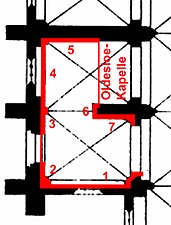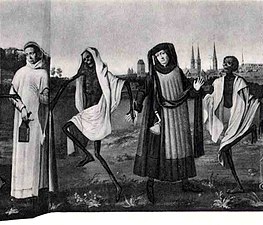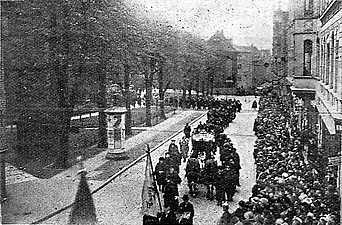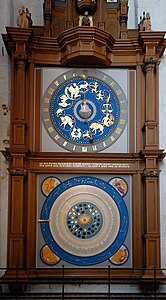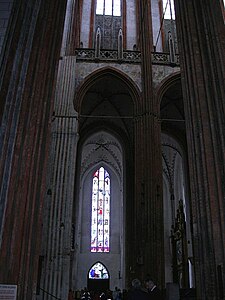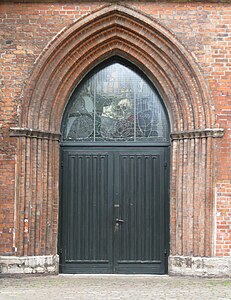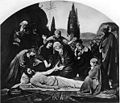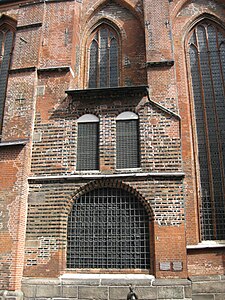Chapels of the Marienkirche in Lübeck
The nineteen chapels still existing today characterize the interior of Lübeck's Marienkirche as the so-called hall of fame of the Lübschen patriciate and together with the remaining epitaphs of Lübeck's Marienkirche still give an impression of the connection between the city and its dominant bourgeois families with its council and market church. The grave chapels on the north side of the nave were built between 1328 and 1350 from east to west. They were redesigned in 1837. From 1350 to 1385 the burial chapels were built on the south side. The air raid on Lübeck in 1942 destroyed most of the furnishings in the chapels, as well as many of the remaining altarpieces in Lübeck's Marienkirche . The following list first shows the chapels on the north side from west to east, then following clockwise the chapels in the choir. This is followed by the chapels in the area of the two towers from north to south and the chapels on the south side of the nave also from west to east. It describes the respective history, the condition and the equipment up to 1942 as well as the current use and equipment after the reconstruction of the church.
N1: Rodde Chapel
The Rodde Chapel is the westernmost burial chapel on the north aisle of the Marienkirche. It bears its name after the councilor merchant family Rodde . It was donated by Heinrich Witte between 1359 and 1387. 1497 Foundation of a vicariate by Christian Northoff and his siblings.
N2: Bremen chapel
The original donor of this chapel is unknown; probably the chapel of Michael Schutte and his family. In the second quarter of the 16th century owned by Goswin Bütepage and his family. Has been owned by the Bremer family since 1553 and administered by the head of the Bremen will.
N3: Koehler Chapel
This burial chapel was first mentioned in 1336; it was built by the councilor and church mayor Gottschalk Warendorp . The chapel was owned by the von Wickede family in the 16th century . It was acquired in 1635 by Lübeck's mayor Anton Köhler as a grave chapel for the family and was destroyed in 1942. Part of the wrought-iron baroque lattice of the chapel has been preserved and is located at the Warendorp chapel.
N4: Wöhrmann Chapel
1347 mentioned as a chapel of the citizen Hermann Keizer. It came into the possession of the Runge family in the 16th century. In 1776 she was buried by the silk merchant and head of the church Hinrich Wöhrmann as a burial place for himself († 1785) and his wife Catharina Engel, née. Tesdorpf († 1789) and contains a memorial stone for his great-grandson Christian Heinrich von Wöhrmann .
N5: Sexton Chapel
Erected in 1328 by the councilor and head of the church Arnold Wlome († 1329) and consecrated to St. John the Evangelist. Wlome the Church donated three vicarages and in 1326 one in Lübeck Cathedral prebend erected. Since 1627 sexton chapel.
Dance of the Dead band
Not actually a chapel, but the north transept with two vaulted yokes. Until it was destroyed in 1942, the Lübeck Dance of Death by Bernt Notke was located here , the epitaph for Mayor Lorenz Möller from the workshop of Eckernförde carver Gudewerth and, above his door, the so-called Kaiserfenster given to the city by the Kaiser in 1913 when he visited Lübeck.
The imperial window was 11 m high. The coats of arms of the Hohenzollern and the Nuremberg burgraves were on its base. Its pictorial representations represented episodes from Lübeck's history. The main picture showed the confirmation of the privileges by Emperor Friedrich Barbarossa in 1181. In the upper third, the Bible and chalice indicated the introduction of the Reformation in Lübeck. On both sides there were medals with the portrait of the reformer Bugenhagen (first Lübeck superintendent). At the top the Lubeca was depicted with a model of a sailing ship and the city arms, in the pointed arch itself the old Swabian coat of arms of the Hohenstaufen crowned by floating putti.
Until 1942, on the east wall of the chapel, the oldest organ in St. Mary's Church was the dance of death organ.
Today in the dance of death chapel there is the new astronomical clock made by Lübeck clockmaker Paul Behrens in the place of the earlier dance of death organ . The new dance of death organ was therefore installed in the north aisle. The window glazing comes from Alfred Mahlau and takes up themes from the burned dance of death. In the tympanum above the portal of the chapel there is a dance of death scene created by Markus Lüpertz .
N6: St. Johannis and Nikolai Chapel (†); N7: Oldesloe Chapel (†)
The N7: Oldesloe Chapel (donated in 1398 by Gerhard Oldesloe) was installed between the Totentanzkapelle and the north aisle , and the N6: St. Johannis and Nikolai Chapel (proven in 1425) in the transept on the northwest side of the pillar . Both are no longer available today.
O1: Old sacristy
Also called the Gerwekammer (chamber where the liturgical vestments were kept). Restored in 1847 by Carl Julius Milde for the installation by Friedrich Overbeck : The mourning for the indigenous Son of God and Jost de Laval's adoration and baptism of Christ . Brass grave slab of Hermen Hutterock, who died in 1505, and his wife, probably a design by Bernt Notke . Today prayer chapel. The library used to be on the upper floor.
O2: Gallin and Alen Chapel
Two-storey extension; on the ground floor chapel of the Gallin family, built by the executors of the mayor Hermann Gallin († 1365), who was buried in it . Hermann Gallin had also donated a vicariate. On the upper floor is the chapel of the brothers Nikolaus and Eberhard von Alen, donated to the councilor Holto von Alen in memory of their father, who died in 1367 . Reconstruction in 1849/50 together with the old sacristy. Sacristy since 1851 . The remains of the Gothic high altar of St. Mary's Church stood here .
O5: Singers' band
The singers chapel, even Little Office of Our Lady - or confessional , behind the altar in the east of the choir is a choir extension of the Marienkirche in Lübeck by the Council before 1444. At the same time was also the Marientidenkapelle of Lübeck Cathedral . The mayor Hinrich Castorp and other members of the council made a donation to the chapel for regular masses in 1462. In the 19th century, Friedrich Overbeck's entry of Christ into Jerusalem and the Greveraden altar from the Greveraden chapel were shown here. The salvaged Gothic stained glass of the windows of the castle church from the broken church of the castle monastery was installed in the windows of the chapel in 1840. These works of art were destroyed in 1942.
After the Second World War, the Antwerp altar was re-erected here with the Annunciation scene by the master from 1518 , who had survived the destruction in the letter chapel.
A memorial plaque cut in alabaster for the mayor Hermann von Vechtelde with a Latin inscription written by David Chyträus from the epitaph Vechteldes, which was broken off in 1800 due to dilapidation, is on the north wall of the Marientidenkapelle.
On the south wall of the chapel hangs today the painting of the vision of the prophet Ezekiel of the resurrection of Israel by Johannes Willinges , the only remaining part of the epitaph for Heinrich Wedemhof .
W1: Greveraden Chapel
Adolf Greverade 1493. Under the Norderturm, had Gothic glass windows from the broken castle church. In addition to the Greveradenkapelle, there was another and not identical chapel under the north tower: the Holy Cross Chapel (W2). The Paulus window from the former castle church of the castle monastery was restored in 1840 and inserted in the window of the Greveradenkapelle in the western front of the Marienkirche in the course of the neo-Gothic renovation of the west facade in 1868.
Other lost works of art from the Greverade Chapel:
As a gift from Lübeck's mayor Johann Martin Andreas Neumann , a plaster cast replica of the crucifix from the Vadstena monastery church was made for the exhibition Lübeckische Kunst outside Lübeck . The original is attributed to the master of the Darsow Madonna .
W3: Bergen driver chapel
The mountain drivers had their chapel with the mountain driver altar between the two towers. It was established around 1400 when its St Olavs Altar is first mentioned. The chapel was richly furnished. The mountain driver's stalls, built in 1518, were already located in the main nave directly in front of the chapel to the left and right of the baptism under the great organ that stood there until the Second World War. The crucifixion window from the former castle church of the castle monastery was originally located together with the Jerome window on the north side of the choir of the castle church. It was installed in the course of the neo-Gothic redesign of the west facade of the Marienkirche in the 19th century above the west portal of the Marienkirche in the Bergenfahrer chapel. It was supplemented with the Coronation of Mary , donated by the Lübeck Council in 1521 , which was removed from the chapel in 1839 to make room for more windows in the castle church.
W4: Schinkel Chapel
The chapel under the south tower named after the merchant Arnt Schinkel , who founded a vicarie here in 1497. Schinkel's transgrave plate, which is rare for northern Germany , was lost in 1942.
Today memorial with the smashed bells that fell in the fire in 1942.
S1: Letter Chapel
Built from 1310 as St. Anne's Chapel; the name letter chapel is post-Reformation and is derived from the scribes who had their classes in the chapel. In the chapel, which remained largely undamaged in 1942, was the Antwerp altar from 1518, which is now placed in the Marientid chapel again.
Late Gothic wall cupboard, portrait of the shipwreck of the mountain driver Hans Ben, grave slab of Bruno von Warendorp , organ from East Prussia; today used as a winter church.
S2: Divessen Chapel
Donated by the will of the citizen Heinrich Vlint, who died in 1367, passed to Heinrich Divessen and his family in 1438. Today it contains a modern toilet facility for visitors.
S3: Segeberg Chapel
Founded by Timm von Segeberg († 1364) and equipped with two vicarages. Later managed by the Segeberg Foundation together with the Segeberg poor house in Johannisstrasse.
Today memorial chapel for members of the Eschenburg family .
S4: Stotebrugge Chapel
Erected from the estate of Arnold Levendige († 1352). Later owned by the Muter and Stotebrugge families; under the chapel a crypt with 18 graves.
S5: Warendorp Chapel
Donated by Wilhelm Warendorp, who died in 1359, the son of the mayor Bruno Warendorp ; Burial chapel of the patrician family von Warendorp . Contains the classicistic monument of Mayor Joachim Peters von Landolin Ohmacht from 1788 and a remnant of the lattice of the Koehler Chapel from 1656.
S6: Holy Three Kings Chapel of the Novgorod Drivers (†)
The chapel was located on the east wall of the south vestibule and has been attested as the Novgorod drivers' chapel since 1439 . A bookseller's storage room since 1653, the chapel was demolished in 1768. Only traces in the east wall indicate a holder in which there were wooden sculptures of an Adoration of the Magi.
S7: Tesdorpf Chapel
The chapel was built in 1385 at the latest. On September 20 of this year, Bertholt Holthusen, whose tombstone was still in it in 1720, donated three vicarages to an altar he had erected. and on November 11th, he issued a certificate of the purchase of two brawn pans, the main income of which was to go to these vicariates located “in the capellen by denhilghen dreu koninghen”.
In popular parlance in the 16th and 17th centuries, the chapel had the nickname "dat Vynkenbur", borrowed from the upper part of the butter shop on the market square. From the beginning of the 17th century until 1825, the Holy Cross Chapel served as a meeting room for the church's deacons or poor carers. In 1714, Mayor Peter Hinrich Tesdorpf , who was buried in it ten years later , bought it for 1,300 marks, his epitaph is on the south wall of the vestibule, and from then on remained in the family's possession. After its roof was covered with copper in 1825, it was prepared in 1835 by Gottfried Schadow for the display of the marble bust of the mayor Johann Matthaeus Tesdorpf, who died in 1824, by Gottfried Schadow . Your window, which was clad from the inside with a board wall on this occasion, was replaced by a double panel in 1875. The brightly colored coat of paint it had been wearing since 1887 was renewed in 1903. He disappeared when the church was rebuilt.
- Tesdorpf Chapel
O8: Mayor's Chapel
First documentary evidence from 1289, the Trese on the first floor has been used as a treasury and document archive for the Lübeck City Council since 1289 .
The results of a tender for the memorial from 1920 were publicly exhibited in the mayor's chapel. From 1929 the memorial stood for the 318 fallen in the First World War in the community.
The Devil's Stone, which is located at that point today, was at that time at the foot of the south tower.
O6: Molen Chapel
The Molen Chapel, also known as the gloomy chapel , was built in 1395 from the estate of Hermann van der Molen. On its altar was the Gothic Marienretabel, donated by Christian Swarte in 1495 (today on the high altar). It had its own entrance from the ambulatory that was walled up today.
literature
- Gustav Schaumann , Friedrich Bruns (editor): The architectural and art monuments of the Free and Hanseatic City of Lübeck. Edited by the building deputation. Volume 2, part 2: The Marienkirche. Nöhring, Lübeck 1906 ( digitized version ).
- Walter Paatz : The Marienkirche in Lübeck. Volume 5 of the series Deutsche Bauten , 2nd edition, Burg near Magdeburg 1929
- Max Hasse: The Marienkirche in Lübeck . Deutscher Kunstverlag, Munich 1983, ISBN 3-422-00747-4 , especially pp. 167–173: The private chapels and the side altars with their vicariums and commends and plan p. 243
- Antje Grewolls: The chapels of the north German churches in the Middle Ages: architecture and function. Kiel: Ludwig 1999, ISBN 3-9805480-3-1 , pp. 179-194
- Adolf Clasen : Unrecognized treasures - Lübeck's Latin inscriptions in the original and in German. Lübeck 2002, p. 48 f. ISBN 3795004756
Web links
Individual evidence
- ↑ The BuK statement that it was donated by Johann Geismar, councilor in Stockholm, refers to an altar, not to this chapel.
- ↑ Fehling, Council Line No. 313.
- ^ The imperial gift for the Marienkirche , In Vaterstädtische Blätter : Issue of June 13, 1914
- ^ Walter Paatz: Die Marienkirche zu Lübeck , p. 35.
- ↑ Fehling: Council Line , No. 368.
- ^ After Grewolls, p. 186; BuK and Hasse identified the Alen chapel with the old sacristy / Gerwekammer, but this does not correspond to tradition.
- ^ Text with translation by Adolf Clasen : Misunderstood treasures. Lübeck's Latin inscriptions in the original and in German. Lübeck 2003, pp. 38/39. ISBN 3-7950-0475-6
- ^ So Grewolls versus Hasse et al. a.
- ↑ Figure Buk II, p. 183
- ↑ Illustration of the original in Vadstena
- ↑ Fehling, Ratsline , on the descendants and councilor Konrad Schinkel , No. 786, with reference to BuK II, pp. 171, 213.
- ↑ Schaumann, Gustav; Bruns, Friedrich (editor): The architectural and art monuments of the Free and Hanseatic City of Lübeck , ed. from the building deputation. Volume 2, part 2: The Marienkirche . Nöhring, Lübeck 1906, p. 389
- ↑ Rudolf Struck : The Lübeck family Segeberg and their relations to the universities of Rostock and Greifswald , in: Journal of the Association for Lübeckische Geschichte und Altertumskunde, ISSN 0083-5609 , Vol. 20 (1919), 1, pp. 85-116
- ↑ Increasing the Council's silver treasure. In: Vaterstädtische Blätter , year 1908, no. 50, issue of December 13, 1908, pp. 197–198.


